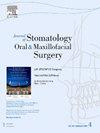不同年龄、性别无牙上颌不同区域骨小梁骨密度和骨高的定量评价
IF 1.8
3区 医学
Q2 DENTISTRY, ORAL SURGERY & MEDICINE
Journal of Stomatology Oral and Maxillofacial Surgery
Pub Date : 2025-03-03
DOI:10.1016/j.jormas.2025.102306
引用次数: 0
摘要
在无牙上颌,骨的数量和质量是决定种植计划和成功的关键因素。本研究旨在评估无牙上颌骨不同区域骨小梁骨密度(TBD)和骨高的变化,根据性别和年龄。材料与方法对100例无牙上颌骨锥束ct (CBCT)进行分析。六个虚拟种植计划在上颌鼻窦之间的切牙,犬齿和前磨牙的位置。根据可用骨体积选择虚拟种植体长度并用于估计骨高度。TBD记录在每个虚拟种植体顶点中心的Hounsfield单元(HU)中。双样本t检验比较了男性和女性的平均TBD和平均虚拟种植体长度。Spearman相关系数分析平均TBD与年龄、平均TBD与平均虚拟种植体长度的相关性。显著性水平设为5%。结果男性平均TBD和平均种植体长度显著高于女性(P = 0.033和P = 0.003)。在女性中,平均TBD与年龄呈负相关(rho = -0.352, P = 0.022),平均TBD与平均种植体长度呈负相关(rho = - 0.425, P = 0.005)。无牙上颌骨TBD和骨高的变化与性别有关。老年无牙妇女更容易出现前上颌低TBD和低骨高,这可能影响种植成功的治疗选择。本文章由计算机程序翻译,如有差异,请以英文原文为准。

Quantitative evaluation of trabecular bone density and bone height in different regions of edentulous maxillae according to age and sex
Introduction
In edentulous maxillae, bone quantity and quality are crucial factors for implant treatment planning and success. This study aimed to assess variations in trabecular bone density (TBD) and bone height in different regions of the edentulous maxilla, according to sex and age.
Materials and methods
100 cone beam computed tomography (CBCT) from edentulous maxilla were analyzed. Six virtual implants were planned between the maxillary sinuses at incisor, canine, and premolar sites. Virtual implant lengths were selected according to available bone volume and used to estimate bone height. TBD was recorded in Hounsfield Units (HU) at the center of the apex of each virtual implant. The two-sample t-test compared the mean TBD and the mean virtual implant length between males and females. The Spearman correlation coefficient analyzed the correlation between mean TBD and age, and the correlation between mean TBD and mean virtual implant length. The significance level was set at 5 %.
Results
In males, mean TBD and mean implant length were significantly higher than in females (P = 0.033 and P = 0.003). In females, there was a negative significant correlation between mean TBD and age (rho = -0.352, P = 0.022), and between mean TBD and mean implant length (rho = - 0.425, P = 0.005).
Discussion
Variations in TBD and bone height within the edentulous maxilla are related to sex. Older edentulous women are more susceptible to present low TBD and low bone height in anterior maxilla, which may influence therapeutic choices to achieve implant success.
求助全文
通过发布文献求助,成功后即可免费获取论文全文。
去求助
来源期刊

Journal of Stomatology Oral and Maxillofacial Surgery
Surgery, Dentistry, Oral Surgery and Medicine, Otorhinolaryngology and Facial Plastic Surgery
CiteScore
2.30
自引率
9.10%
发文量
0
审稿时长
23 days
 求助内容:
求助内容: 应助结果提醒方式:
应助结果提醒方式:


